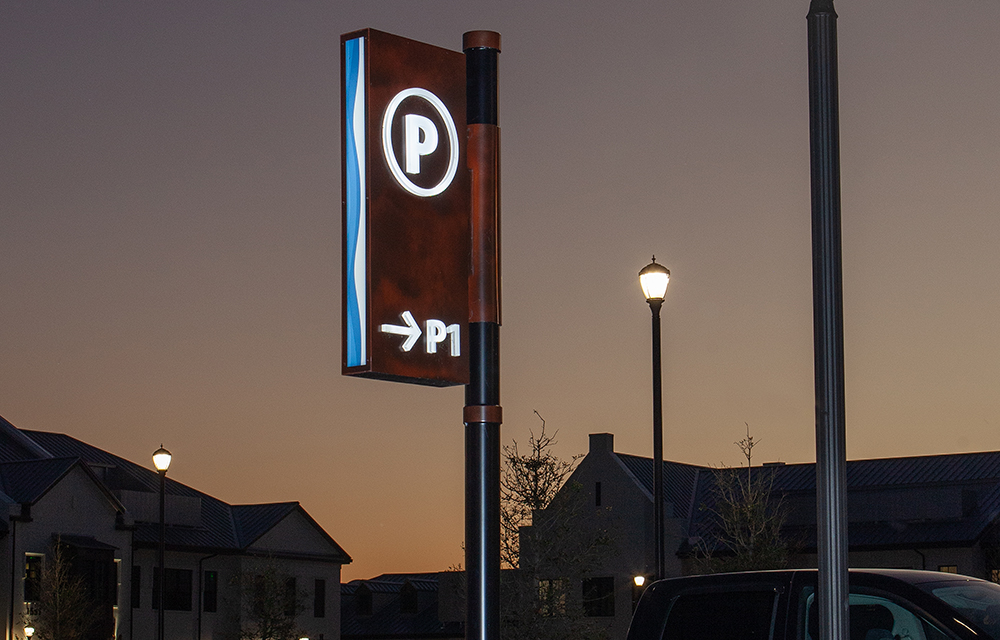Do complex wayfinding projects make you feel like a deer in the headlights? Don’t worry; you’re not alone! Many other sign shop owners feel the same way.
Picture this: You’re an electric sign shop owner (that was me), nodding your head in agreement to your architect client saying, “Sure we can do your wayfinding project!”
Then the real fun begins! You must navigate your way through a maze of sign placement—deciphering ADA requirements, wondering if you can stick to the demanding schedule for making and putting up the signs, etc.
It’s like trying to juggle flaming kittens while riding a unicycle—challenging but, with the right plan, very doable!
Here are a few steps that can help you approach your next (or first) wayfinding project with confidence.
Understand Your Client’s Needs
Schedule an initial discovery call with your client to begin to understand their specific goals and requirements for the project.
What problems are they trying to solve? Is there a budget? (Note: Don’t shy away from asking this question—budgeting and cost transparency is critical for both you and your client).
Also what are the timelines and can you realistically deliver on their desired dates? Who is their target audience? Are there any unique challenges or constraints to consider?
A clear understanding of the client’s needs will guide the entire project. It also communicates that your sign company really cares about their success—and that always starts with listening.
Comprehensive Site Survey
Conduct a detailed site survey to gather crucial information about the physical environment. This includes assessing the property layout, traffic patterns, potential obstacles, and existing signage. A thorough survey helps in determining optimal sign placement and ensuring that the ADA/wayfinding system seamlessly integrates with the environment.
While on site, determine the type of equipment your staff requires to accomplish the job (cranes, augers, lifts, accessibility to the site, etc.).
It’s a bit easier to do site surveys when you’re replacing old signs. But if it’s a new construction project, you’ll have to rely on site plans, floor plan layouts, and building elevation drawings (more on those later in the article).
Communicate Frequently
It’s always important to keep your client in the loop as the project progresses.
For new construction projects, it’s also important to have regular meetings with the general contractor to make sure nothing changes along the way. Plans can sometimes shift during construction so stay in the loop by attending their on-site construction meetings. These are really helpful to avoid mistakes during installation.
The more you talk to the general contractor, the fewer change orders will occur—and that will keep your clients happy too.
Offer User-centered Design
Always keep the user in mind when creating sign designs for wayfinding projects. Design signs that are easy for people to understand. In fact, when it comes to designing ADA/wayfinding signs, many companies call it “Environmental Graphic Design” (EGD). But a better term to use is “Experiential Graphic Design.” Let me explain.
In a recent podcast, I interviewed Lauren Stern from Studio 618. She sees herself as more of a storyteller than just a sign designer. Her main goal is to help her clients convey their stories through signage.
So when you’re working on sign designs, think about what your clients want to say to their audience through the signs. That’s the heart of the design process.
Consider things like how easy the signs are to read, the clarity of the messaging, and the consistency of the designs. Also think about the quality of the materials you’re using and what that communicates to the user.
It’s important to think beyond just basic sign design. Consider how the signs can enhance the user’s experience in a space. Do the designs make people feel like they’re in a calming place, a modern office, or a luxurious apartment complex?
Thinking about how users feel can really make a difference in your design work. Give it a try. It will take your designs to the next level!
Regulatory Compliance
Be well-versed in local regulations and ADA compliance standards related to signage, accessibility, and safety. Ensure that all signage designs and installations meet these requirements, to avoid costly mistakes and delays.
And when you’re on site for new construction projects, always follow OSHA safety rules like wearing vests, hardhats, safety glasses, and the right shoes. Safety first! The general contractor will appreciate it.
Learn How to Read Plans
Building elevation plans will help determine placement and attachment methods for main building signs and address numbers. You’ll also need elevation plans for permitting.
Site plans are your guide for deciding where to put signs that direct customers or tenants to the right places on the property. These signs are usually found in parking garages or parking lots for traffic control, as well as main entrance signs (such as pylons or monuments).
Floor plans will help calculate sign counts for all doorway signs, room numbers, stairwells, restrooms, egress maps, and required fire code signs. These are the sign types that typically require Braille.
Sign Pro Tip #1
When installing exterior signs on a building, make sure to find out how they’ll attach to the parapet, as well as any required mounting height per local permit codes.
And for freestanding signs near the road, double-check the easements. I had to learn these lessons the hard way!
Sign Pro Tip #2
Never give away your designs for free. Just like they cost you time and effort, they should have a price tag for your customers too.
A good rule of thumb is to charge at least 10 percent of the total sign package value for your designs. For example, if the sign package is worth $100,000, charge $10,000 for the designs. It’s fair and ensures your work is valued.
Conclusion
I know this sounds like a lot—and it might seem like a big step for your sign shop—but the payoff is worth it!
You don’t have to try to do this alone. Partner up with a professional ADA/wayfinding wholesale sign manufacturer. They’ll be a huge resource for evaluating project plans, provide installation guidelines, make sign samples, and advise you on the best materials to use to ensure the project is within budget. It’s a great way to expand your business in a direction you won’t regret.
Now go make great signs!
Joe Arenella is the owner of SignTracker and host of the Behind the Signs Facebook group and YouTube channel.











